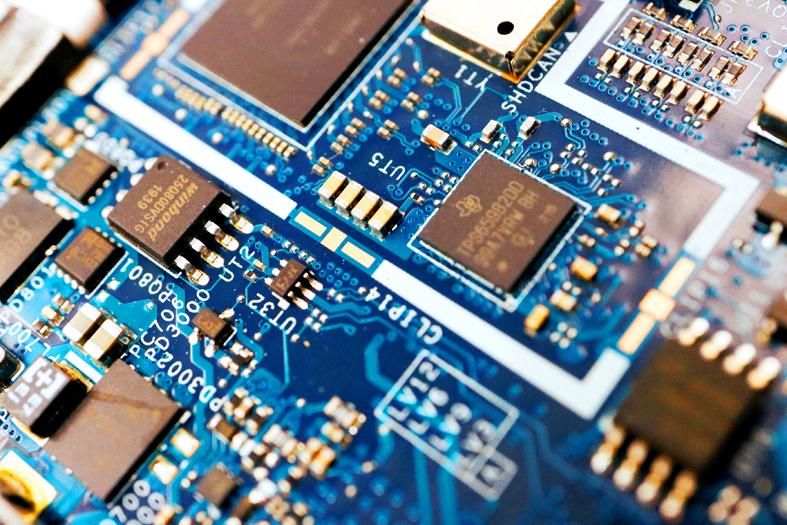The US is imposing export controls on technologies that support the production of advanced semiconductors and turbines, protecting against their “nefarious” military and commercial use.
The innovations “are essential to the national security” of the US and meet the criteria for the protection, the US Department of Commerce’s Bureau of Industry and Security said in a statement on Friday.
The agency creates and enforces export restrictions.

Photo: Reuters
“Advancements that allow technologies like semiconductors and engines to operate faster, more efficiently, longer and in more severe conditions can be game changers in both the commercial and military context,” US Under Secretary of Commerce for Industry and Security Alan Estevez said in the statement.
The move came as the US seeks to hinder the ability of China, which it sees as a strategic competitor, from developing advanced chipmaking technologies. It also follows passage this week of US legislation that includes about US$52 billion to boost domestic semiconductor research and development, and aims to bring more chipmaking back to the US.
“We are protecting the four technologies identified in today’s rule from nefarious end use by applying controls through a multilateral regime,” US Assistant Secretary of Commerce for Export Administration Thea Rozman Kendler said in the statement.
The statement highlighted three technologies targeted by the controls, including two substrates of ultra-wide bandgap semiconductors: gallium oxide and diamond.
Chips made with these materials can work under more severe conditions, such as at higher voltages or temperatures, and devices that use them have “significantly increased military potential,” it said.
The electronic computer-aided design software, made for the development of integrated circuits with gate-all-around field-effect transistor structure, is also targeted, it said.
The software is used by military and aerospace-defense industries to design complex integrated circuits. Gate-all-around field-effect transistor structure is key to designing technology that enables “faster, energy efficient, and more radiation-tolerant integrated circuits” that have military uses, including defense satellites, it said.
The third technology is pressure-gain combustion, which it said can be used in rockets and hypersonic systems.

AIR SUPPORT: The Ministry of National Defense thanked the US for the delivery, adding that it was an indicator of the White House’s commitment to the Taiwan Relations Act Deputy Minister of National Defense Po Horng-huei (柏鴻輝) and Representative to the US Alexander Yui on Friday attended a delivery ceremony for the first of Taiwan’s long-awaited 66 F-16C/D Block 70 jets at a Lockheed Martin Corp factory in Greenville, South Carolina. “We are so proud to be the global home of the F-16 and to support Taiwan’s air defense capabilities,” US Representative William Timmons wrote on X, alongside a photograph of Taiwanese and US officials at the event. The F-16C/D Block 70 jets Taiwan ordered have the same capabilities as aircraft that had been upgraded to F-16Vs. The batch of Lockheed Martin

US President Donald Trump yesterday announced sweeping "reciprocal tariffs" on US trading partners, including a 32 percent tax on goods from Taiwan that is set to take effect on Wednesday. At a Rose Garden event, Trump declared a 10 percent baseline tax on imports from all countries, with the White House saying it would take effect on Saturday. Countries with larger trade surpluses with the US would face higher duties beginning on Wednesday, including Taiwan (32 percent), China (34 percent), Japan (24 percent), South Korea (25 percent), Vietnam (46 percent) and Thailand (36 percent). Canada and Mexico, the two largest US trading

GRIDLOCK: The National Fire Agency’s Special Search and Rescue team is on standby to travel to the countries to help out with the rescue effort A powerful earthquake rocked Myanmar and neighboring Thailand yesterday, killing at least three people in Bangkok and burying dozens when a high-rise building under construction collapsed. Footage shared on social media from Myanmar’s second-largest city showed widespread destruction, raising fears that many were trapped under the rubble or killed. The magnitude 7.7 earthquake, with an epicenter near Mandalay in Myanmar, struck at midday and was followed by a strong magnitude 6.4 aftershock. The extent of death, injury and destruction — especially in Myanmar, which is embroiled in a civil war and where information is tightly controlled at the best of times —

China's military today said it began joint army, navy and rocket force exercises around Taiwan to "serve as a stern warning and powerful deterrent against Taiwanese independence," calling President William Lai (賴清德) a "parasite." The exercises come after Lai called Beijing a "foreign hostile force" last month. More than 10 Chinese military ships approached close to Taiwan's 24 nautical mile (44.4km) contiguous zone this morning and Taiwan sent its own warships to respond, two senior Taiwanese officials said. Taiwan has not yet detected any live fire by the Chinese military so far, one of the officials said. The drills took place after US Secretary